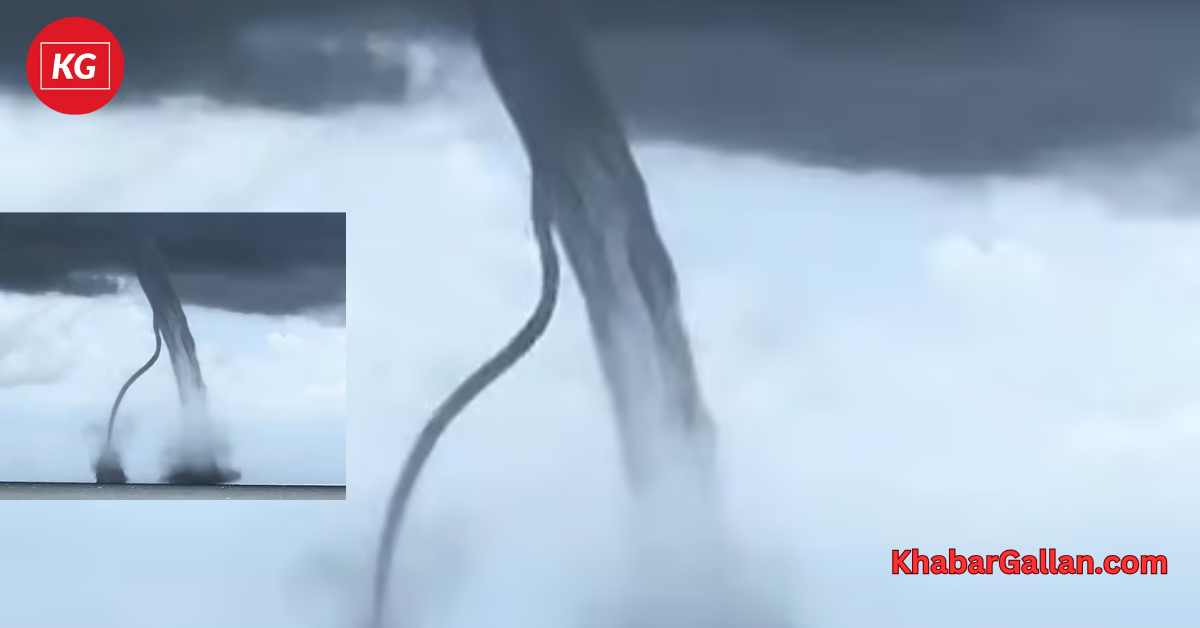In early August 2025, visitors aboard a tour boat cruising the Po River Delta witnessed a captivating—and rare—natural spectacle: two majestic waterspouts swirling side by side over the Adriatic Sea, eventually merging into a single vortex. The scene, captured on video by the tour operator and shared widely on the Emilia‑Romagna Meteo Facebook page, quickly circulated across the globe.
Moments earlier, on a beach in Maccarese—north of Rome—a sudden whirlwind struck, sending parasols, towels, and beach gear flying as frightened tourists bolted for safety. At least one person sustained minor injuries. These twin events unfolded on the same day, highlighting extreme and unpredictable summer weather across northern Italy.
🌪️ What We Saw: Nature Performing
- Two swirling waterspouts danced across the sea, each spiraling from dark storm clouds into the water, before gracefully merging into one twisting mass.
- No damage or injuries were reported from this aerial ballet, but on shore the story was more chaotic—a sudden mini‑tornado turned calm into chaos at Maccarese Beach, with tourists scurrying away from flying umbrellas and debris.
What Are Waterspouts?
Let’s break it down:
- Definition: A waterspout is a rotating column of air and mist that forms over a body of water. It resembles a tornado, but typically weaker unless it’s a tornadic or mesocyclonic type.
- Types:
- Fair‑weather waterspouts originate outside thunderstorms and are usually benign.
- Tornadic waterspouts form within supercells and can be more intense.
- Frequency in Europe: Europe sees around 500 waterspouts annually. Italy averages about 25 per year, most often between late summer and early autumn.
Why Now? Climate Factors at Play
Several environmental conditions converged:
- Warm Mediterranean waters this season are fueling thunderstorms. Sea surface temperatures have been recorded significantly above average—up to 3 °C hotter—creating a volatile atmosphere ripe for vortex formation.
- Unstable weather patterns, including humid air aloft above warm seas, have increased the risk of severe storms over coastal regions, making waterspouts more likely.
Experts caution that climate change may not directly cause each event but does amplify the factors that produce extreme weather, such as higher sea temperatures and unstable air masses.
Historical Context & Noteworthy Precedents
- In November 2023, Salerno on Italy’s Amalfi coast witnessed up to 20 waterspouts in a single day, a rare display though thankfully with no major damage.
- In August 2024, a series of waterspouts off northern Italy and Sardinia included multiple simultaneous columns—one reportedly sinking a luxury yacht near Sicily.
- Though not frequent, such events have precedent in Italy’s coastal history, occasionally resulting in localized damage or passenger evacuations.
Human and Cultural Perspectives
The Po Delta, a UNESCO-recognized biosphere hub, is celebrated for its ecological richness and vital wetlands. That tour boat, momentarily anchored, serendipitously provided the perfect vantage for capturing nature’s choreography. Such scenes provoke awe—and restraint: despite their beauty, waterspouts demand caution.
Responders and authorities responded swiftly: Italy’s meteorological service issued a moderate wind warning for northern regions and advised boat operators to follow safety protocols. Residents and tourists were urged to stay alert as more storms are forecast in regions like Marche and Umbria.
What It Teaches Us
- Beauty meets risk: Even stunning natural phenomena can carry danger.
- Nature’s unpredictability: Storm systems can produce simultaneous coastal and marine effects in a single afternoon.
- Climate signals: As sea temperatures rise, unusual weather is more likely—and preparedness becomes critical.
Final Thoughts
The twin waterspouts that merged off Italy’s Po River Delta offered a rare and poetic glimpse into atmospheric power. They remind us that while beauty exists in nature’s spontaneous artistry, we must respect the force behind it. As Mediterranean waters stay warm and global weather patterns shift, such events may become more frequent—and our vigilance, essential.













Leave a Reply